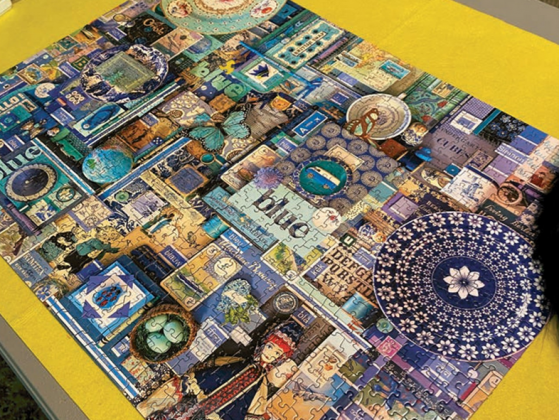By Micah Leigh, Features Writer
Cobble Hill, White Mountain, Sunsout, Buffalo and Ravensburger. If you know what these names have in common, you are probably one of the thousands of jigsaw puzzle enthusiasts who have been busily puzzling away during the pandemic. These are all names of popular puzzle brands that have seen the demand for puzzles surge like never before. Ravensburger alone is reportedly up 370% from this time last year. Puzzle companies worldwide have cranked up production, but customers still may have to wait weeks for their orders.
“My grandmother always had a puzzle out when I was growing up,” said Vicki Keith of Nederland. “We did them as a family, but then life got busy and I stopped doing them. When the lockdown came and I got all my projects done, I had lots of free time. I thought a puzzle would be fun. I was shocked to find out they were so hard to find.”
Keith did manage to find a 300-piece puzzle. “It was so much fun. From there, I went to 500 piece puzzles. Then a friend shamed me into stepping up to 1000-piece puzzles. I have four unopened boxes right now and two more coming from Amazon. I’m also buying stacking trays and other accessories.”
Building jigsaw puzzles has been shown to improve cognitive function, improve spatial reasoning and attention to detail. Working puzzles also improves memory, increases your IQ and improve problem solving ability. It is also a great way to relieve stress.
“I find it very relaxing,” said Keith. “It’s so satisfying when you find that perfect piece. It gives my brain a workout. And when you are finished, you have a beautiful piece of art.”
Doing puzzles at grandma’s house seems to be a favorite memory. A quick survey of Jigsaw Junkies, a Facebook group for puzzlers, drew over 400 responses from puzzle lovers who grew up working them with family members.
“Puzzles are nostalgic for me,” said Audrey Mitchell of Nederland. “Growing up in North Carolina, we had occasional snow storms. Out came a puzzle. It was left out so we could walk by, pick up a piece or two when we felt like it. We also took them to the beach on summer vacations and worked them on rainy days.”
When the pandemic hit, Mitchell immediately thought of puzzles but was shocked that prices were so high. She quickly learned to order directly from the puzzle companies because Amazon prices were driven up by third party vendors.
“My ‘go-to’ company right now is Ravensburger,” said Mitchell. “They are light hearted. I don’t want one that is like ‘homework.’ Five hundred to 750-piece puzzles are my jam. I don’t have a table big enough for anything bigger. Doing puzzles keeps me off my phone and away from television. I find it calming. I can sit and sip wine and listen to music. And it’s a sense of accomplishment when you snap that last piece into place. After I admire my work for a while, I break it all down and put it in Ziplock bags.”
There are many ways to approach a puzzle, but most people start by building the edges.
“I sort out colors, tones, and shapes, and then go from there,” said Mitchell. “My son-in-law takes a different approach. He will sit and stare at the box looking for a specific piece.”
From landscapes to landmarks, cupcakes to teacups, superheroes to puppies and flowers, there are endless choices when it comes to puzzle images. Piece count can start at 100 pieces and go all the way up to Kodak’s World’s Largest Puzzle with 51,300 pieces. This enormous puzzle sells for $400-$600. Not surprisingly, it is out of stock.
Puzzle hacks
Is puzzle dust getting everywhere? Put all the new pieces of a puzzle in a colander before you start assembly. Shake out the dust and discard. Your work surface will now stay clean.
Finding all the border pieces can seemingly take forever. To skip this step, when breaking down a puzzle, put all the border pieces together in a Ziplock bag so you don’t have to spend time looking for them when you do the puzzle again. (Serious puzzlers call this cheating, but who is going to know?)
Work a puzzle on a puzzle mat that can be rolled up and stored if you think you might need to use your work surface for something else before you finish. There is nothing quite so frustrating as getting halfway finished with a puzzle and then having to break it down to move it.
The record for assembling a 1000-piece puzzle is held by a team of two women, Joellen Beifuss and Pam Kerstetter. At the U.S. National Jigsaw Puzzle Championships 1986 in Ohio, this team finished with a time of 1:01:29 hours.
The jigsaw puzzle with the most pieces was built in Ho Chi Minh City, Vietnam, on Sept. 24, 2011. It consisted of 551,232 pieces and had an overall measurement of 48 feet, 8.64 inches by 76 feet, 1.38 inches. The puzzle was a depiction of a lotus and was completed by a team of 1,600 students


